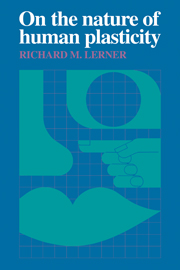Book contents
- Frontmatter
- Contents
- Foreword by Paul Baltes
- Preface
- 1 Perspectives on plasticity
- 2 The life-span view of human development: philosophical, historical, and substantive bases
- 3 Gene marking, recombinant DNA technology, and gene transfer: toward true gene therapy
- 4 Neuroanatomical bases of human plasticity
- 5 Human neurochemistry and the role of neurotransmitters
- 6 Evolutionary biology and hominid evolution
- 7 Comparative-developmental psychological bases of plasticity
- 8 Individual and group interdependencies
- 9 Toward future multidisciplinary efforts
- 10 Conclusions: On the limits of plasticity and the plasticity of limits
- References
- Author index
- Subject index
8 - Individual and group interdependencies
Published online by Cambridge University Press: 22 March 2010
- Frontmatter
- Contents
- Foreword by Paul Baltes
- Preface
- 1 Perspectives on plasticity
- 2 The life-span view of human development: philosophical, historical, and substantive bases
- 3 Gene marking, recombinant DNA technology, and gene transfer: toward true gene therapy
- 4 Neuroanatomical bases of human plasticity
- 5 Human neurochemistry and the role of neurotransmitters
- 6 Evolutionary biology and hominid evolution
- 7 Comparative-developmental psychological bases of plasticity
- 8 Individual and group interdependencies
- 9 Toward future multidisciplinary efforts
- 10 Conclusions: On the limits of plasticity and the plasticity of limits
- References
- Author index
- Subject index
Summary
In this chapter I will focus primarily on the social group as a context for the individual and stress that this context both influences and is influenced by the individual. My goal is to suggest that this bidirectional relation between the individual and the social context within which the individual is embedded may be a key instance of the plasticity of human processes.
Of course, it is possible to focus initially on the group, and not first on the individual; within this more macroscopic emphasis, one may discuss the group as a system of interacting individuals all of whom possess plastic processes and flexibility in influencing and being influenced by one another. In fact, I have discussed elsewhere the nature of, and relation between, these individual and group foci (R. Lerner, 1979, in press) and it is of use to present here some of the key features of these earlier discussions.
A model of individual–context relations
To summarize these other presentations, it is useful to consider the diagram presented in Figure 2. Employing T. C. Schneirla's (1957) terms, this figure illustrates what I described in Chapter 1 as a probabilistic–epigenetic conception of development; in the figure I use the term maturation (“Mat.”) to represent endogenous organism changes and the term experience (“Exp.”) to denote all stimulative influences acting on the organism over the course of its life span.
- Type
- Chapter
- Information
- On the Nature of Human Plasticity , pp. 122 - 145Publisher: Cambridge University PressPrint publication year: 1984



